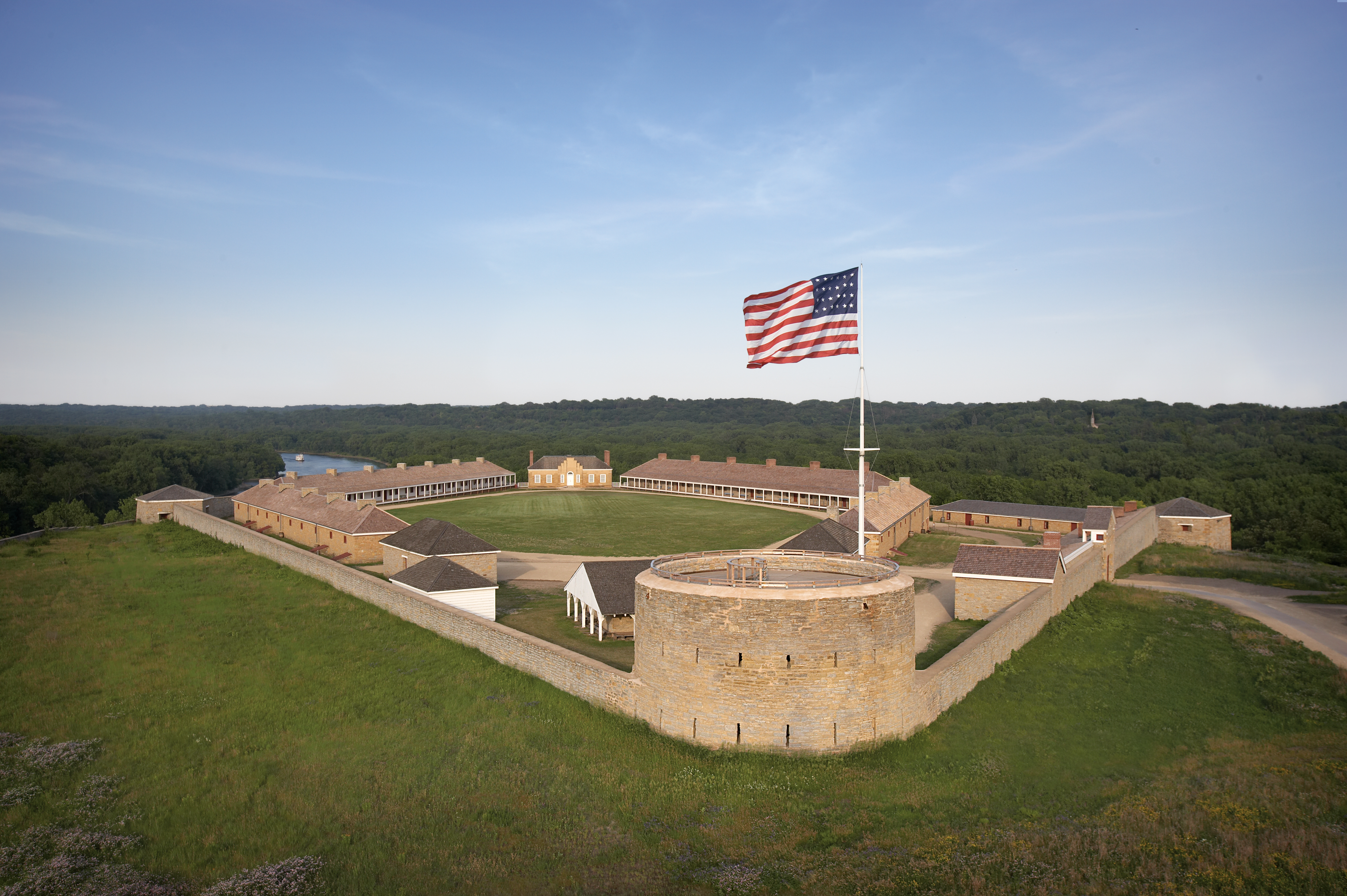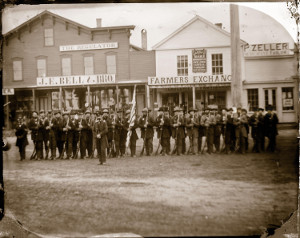
Pre-War: (1812-1860)
Upon expansion of the United States shifted westward explorers would come to find the find which would be the modern day Minnesota. The name derives from the largest river in the state and was given by the Sioux nation meaning sky-tainted water. The predominant tribes that roamed the lands were the Dakota or Sioux and Ojibwe would had contributed to fur trade of the region (Hansen). It was this fur trade that lead to the creation of the frontier post Fort Snelling in 1819, its location on both the Mississippi and Minnesota allowed a centralized position in which it could protect the interests of the United States while creating a friendship with the local tribes (Eastman,1849;Fridley, 1956). Using this a stepping stone in 1849, the United states began to offer trade deals to the tribes of food, tools, and money in exchange for land which could be settled on (Fridley, 1956). These offers were accepted by the tribes and settlers began to work west to the new lands.
It was at this point where true expansion could occur, using Fort Snelling as the nucleus. A surge of new German, Irish and Scandinavian immigrants emerged providing a population push the territory needed in order to be successful. This can be seen in the population tallies held in 1850 and 1860 where the territory grew from roughly 6,900 people to 170,000(Randall,Donald, 2016). The new population were able to develop and establish towns like Minneapolis and Saint Paul making the need for a military post obsolete. So in 1858 the same year that Minnesota officially became a state, the fort was sold to Franklin Steele (Ouisconsin V.C, 1888).
War Times (1861-1865)
With the emergence of the civil conflict within the United States, Minnesota was ready to show it prowess to other states. When war was declared on the Confederate States of America, Minnesota declared they would join the Union army. The mayor of St.Paul Alexander Ramsey happened to be in Washington D.C. and upon hearing the declaration pledged 1000 troops for the Union army. This would be the starting of around 26,000 Minnesota volunteers that would serve in the Union army (Moe, 2009).

While the Civil war was the main concern of the state, a new conflict was beginning to bubble up. It began with the same deals that allowed the state to grow and become a become a state. The United State government had promised money, tools, and food in yearly payments to the Dakota tribes in exchange for lands which the new settlers could build off of. It was not till the United States government’s payment began to be delivered late that the relationship began to tarnish. Soon the payments ceased to be delivered to the tribes. This would greatly impact the tribes which had allowed the settlers to move into their lands. With the new population boom hunting and farming land starved to become scarce forcing the tribes to rely on these payments in order to survive. This caused the tribes to enter a survival state in which they were forced to take what they could (Eastman, 1849)
The conflict escalated in August of 1962 in which four Dakota entered Acton Township. The young Dakota men were hungry and enraged by the breaking of the treaties. This forced them to resort to stealing food from the white settlers, during the act five white settlers were killed. This was the first incident the truly sparked the rebellion. Rallying under their leader Little Crow, the tribes began to take the offensive against the white settlers. This created an internal conflict for the state of Minnesota. The state was in full support of aiding the Union during the Civil war, yet how could they put all their efforts towards the conflict when a rebellion was emerging from under them. The already shaky relationship between the two groups was quickly turning for the worse. Within weeks full out war broke out between the Dakota and settlers. The Dakota tribe was known as warriors among the Native tribes of the area and would show no mercy to those who had taken their land. Battles in place like New Ulm targeted unarmed civilians including women and children rather than government institutions causing an uproar amongst the population.
It was at this time that men from around the state began flocking to Fort Snelling for training to enter the civil conflict. Their travels were not uneventful, as told by a soldier named James Madison Bowler. In several letter home to his wife, James recalled coming across the conflict. Once of which he recalls having to bury men who had been killed and scalped by the attacking tribes (Foroughi, 2008). These types of attacks drove the soldiers onward to receive the needed training in hopes that if they could not make an impact for the Union at least they could make an impact protecting their home.
The next major event came at the Fort Ridgely, which was was considered extremely critical in the survival of the settlers. The fort was in a important position in the southern part of the state, it was the only military post that protected the booming settlements near Hennepin County from the Dakota lands. Little Crow took his men to the Lower Sioux Agency in order to bardter for the aid which have been withheld from him. The Agency had handed over little supplies and an empty promise that the shipment would arrive the following morning. When it had not, the Dakota took actions into their own hands attacking the ill prepared outpost. Outnumbered the men suffered heavy loses with as many as 13 soldiers left dead and 47 wounded compared to the 2 Dakota men who had been killed. The tribes began to break off and raid the nearby smaller settlements who had yet to seek fortifications within larger protected towns.
This had a devastating effect on the state’s ability to supply the Union. Little over a year after Alexander Ramsey pledged his troops to the war, the newly appointed governor Henry Sibley was forced to cry out for aid. This call was delivered directly to president Lincoln and called for aid to put down this uprising. Rather than sending troops from Snelling to assist in the war effect, regiments had to be dispersed throughout the state in order to protect its civilian population. Not only that but a issue began to emerge, what do you do with the Dakota tribes? The settlers wanted blood for those they lost while others like president Lincoln sought another path. That being creating imprisonment camps which could be controlled by Minnesota military. This hit its peak in September 1962 when Sibley lead a push into the homeland of the tribe. In one day his men entered the Dakota camp and took 1200 men, women, and children into custody of the state. Devastating to the tribe’s momentum some 800 more surrendered throughout the next couple weeks(Monjeau-Marz, 2006).
While these events occurred, Fort Snelling was continuing to do the job it was given at the beginning of the war. It continued to train soldiers and citizens on how to survive the warfare. Though it never was in direct fire of either Civil war or the Dakota raids, it provided stability among Hennepin County. It was armed and ready to protect the flourishing part of the state. After Sibley’s raid of the Dakota camps, the fort would begin taking on a new role in the Dakota conflict. It would be home to several “Indian Camps” housing the prisoners for the winter. The true destination was Davenport, Iowa but due to weather the camp was forced to set up on the riverbank underneath the fort. As one would expect, the living conditions were extremely poor almost similar to true prison as a Christian missionary Stephen Riggs wrote in Mary and I. Everyone was tightly packed together and they had limited food, providing a prime opportunity for disease to spread. This in fact took many lives, but for those who survived the winter were packed into steamboats and shipped off (Riggs, 1971). Many having nothing to do with the conflict, their only offence was being of the Dakota tribe (Monjeau-Marz, 2006).
For those who were not put into camps, life was far from civilized. Of those captured 303 Sioux prisoners were put on trial. Unlike a traditional legal system, the trial was handled by a commission of military officers. The next twist was the charges the men were being accused of. Rather than being charged for warfare against the United States, the men were being charged with crimes of civilian level including murder and rape against civilians. Comparing the charges to that of the Confederates after the war, it can be seen unfair regarding the harshness of the sentencing. The ultimate decision came down to President Lincoln who at this point had never had any quarrels with tribes. Of the 303, 38 men were scheduled to be hung in Mankato, Minnesota which was held on December 26th, 1862 (Monjeau-Marz, 2006). This marked the largest mass execution in the history of the country which still stand to this day. Of those hung, two important men were missing. Tribe leaders Little Six and Medicine Bottle who had evaded capture and fled north to Canada. The two were very successful in evading capture, till January of 1864. The two were then set to be hung for their crimes, the location was Fort Snelling. This marked the end to the rebellion on Minnesota soil as further conflicts occurred in what is now North and South Dakota.
Post-War: (1865-Current)
At this point the Civil war had ended, and soldiers had started to return home via boats up the Mississippi River. Completing the journey, from training to returning the civilian life (Moe, 2009). This meant that Minnesota had a chance to flourish once again similar to before the war. With the Dakota conflict ending, additional land was available for settling. Many of which were turned into agriculture (Hansen). As for Fort Snelling, the land around it was leased out by Franklin Steele allowing the fort to expand and eventually have a permanent garrison stationed there. As before the conflicts it provided a strong nucleus for and had influence in the development of the nearby cities like St.Paul.
Primary Sources
[1] Foroughi, Andrea (2008). Go If You Think it Your Duty: A Minnesota Couple’s Civil War Letters. Minnesota Historical Society
[2] Monjeau-Marz, Corine (2006). The Dakota Indian Internment at Fort Snelling, 1862-1864. St.Paul: Prairie Smoke Press
[3] Ouisconsin Van Cleve (1888). “Three Score Years and Ten,” . Printing House of Harrison & Smith
[4] Riggs, Stephen Return. Mary and I: Forty Years with the Sioux. Williamstown, MA: Corner House, 1971.
Secondary Sources
[5] Eastman, Mary (1849). Life and Legends of The Sioux Around Fort Snelling. New York
[6] Fridley, Russell (1956). Fort Snelling From Military Post to Historical Site. Minnesota Historical Society
[7] Moe, Richard (2009). The Last Full Measure: The Life and Death of the First Minnesota Volunteers. Minnesota Historical Society
[8] Randall, J.G, Donald David. (2016) The Civil War and Reconstruction [Second Edition]. Pickle Partners Publishing
[9] Reed, Rowena (1993). Combined Operations in the Civil War. University of Nebraska
